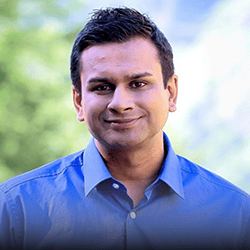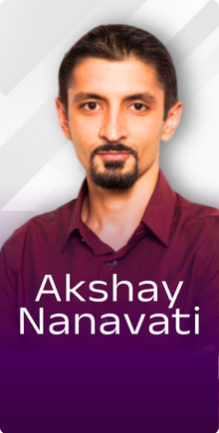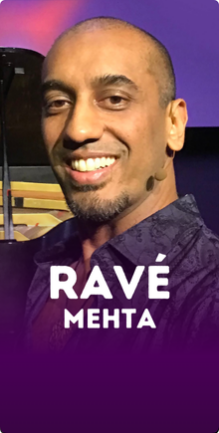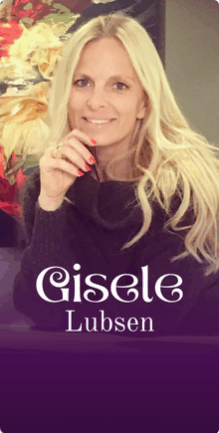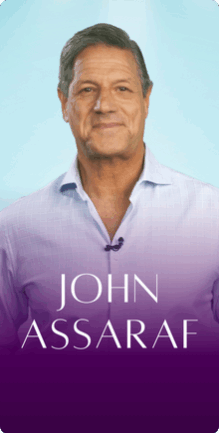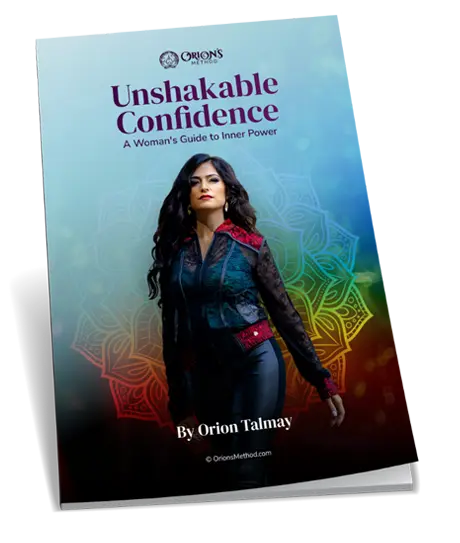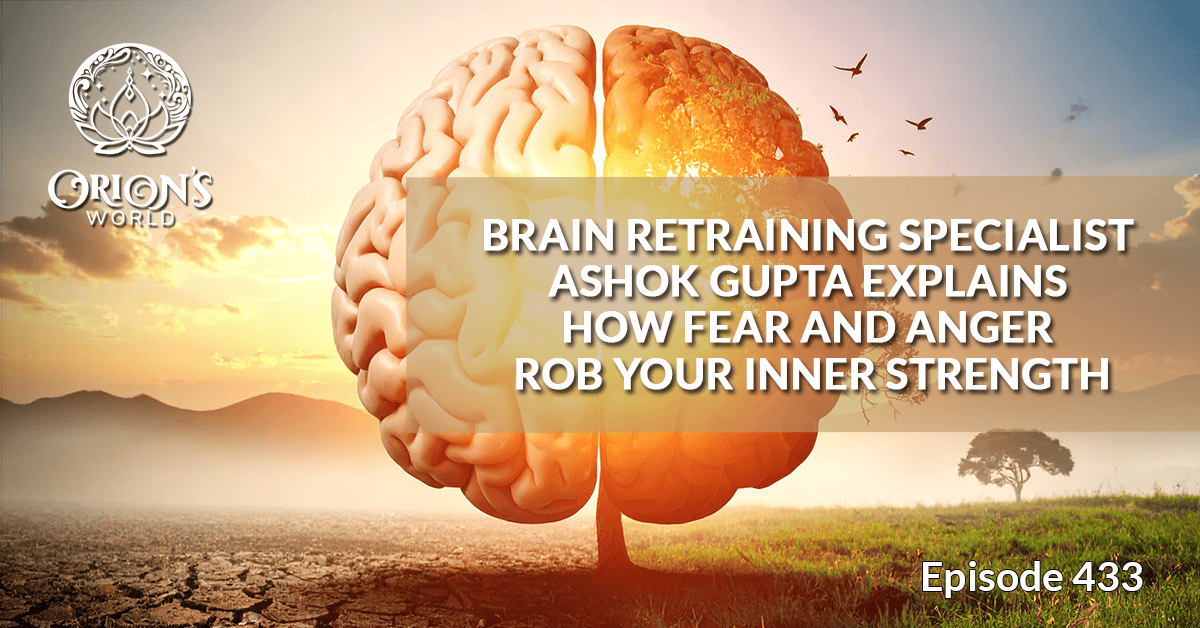
In this Episode
- [03:34]From bedridden Cambridge student to pioneering healer: Ashok’s chronic fatigue journey sparks his revolutionary neuroplasticity discovery.
- [07:42]The game-changing revelation: chronic illnesses aren’t broken hardware but glitched software that can be reprogrammed.
- [09:34]Inside the three-stage healing blueprint: how COVID-19 demonstrates brains trapped in permanent defense mode.
- [13:38]Raw reality check: Orion opens up about bomb shelters, midnight sirens, and stress manifesting as physical chest pain during wartime.
- [19:01]Combat-tested calm: the MEND framework unveiled plus emergency grounding techniques to anchor yourself during crisis.
- [24:38]Counterintuitive truth revealed: surrender amplifies your protective force field while resistance drains your power.
- [30:09]Master emotional balance with the “bike riding” method—find your center without drowning in feelings or stuffing them down.
- [33:29]Hope for the hopeless: why most people can heal from “incurable” conditions by recognizing software vs. hardware problems.
- [34:20]Ashok’s stellar life blueprint: the essential pillars every high achiever needs for sustainable success.
- [39:28]Media detox mastery: protect your nervous system by curating how you consume news and reclaiming ancient evening rituals.
About Today’s Show
Hi, Ashok. Welcome to the show. Thank you so much for being here.
Thank you, Orion, for the invitation. I’m so excited to be able to speak to you.
I’m excited to speak with you because I love learning about how the brain works, and what we thought about brain function 10 years ago, 20 years ago, is completely different than what we are discovering these days. Before we begin, how did you become so fascinated with the brain and neuroplasticity?
My journey started many, many years ago in the late 90s. I was studying as an undergrad at Cambridge. I was living life to the full. I was burning the candles at both ends. Like many students, I’m not looking after my health so much. I got a virus, but I didn’t know what kind it was, so I didn’t think much of it. I had stomach issues, flu, etc., and the virus seemed to go away, but my health became worse and worse and worse.
I felt exhausted, fatigued, and had brain fog; I couldn’t think clearly, and I didn’t know what was happening. If people don’t understand what this feels like, it’s like imagining your worst day of flu times five. That’s how exhausted my body felt. I felt pain, headaches, and I would go from doctor to doctor, and they would say, “We don’t know what you have. We don’t know what causes it. You might have this thing called chronic fatigue syndrome, but we don’t know, and you might have this forever. Goodbye.”
That started my lifelong quest to try and understand what causes these types of very mysterious chronic diseases, like chronic fatigue syndrome, long-term pain, and long COVID. We know lots of people who have long COVID. I did some research, and it was one poignant moment when I was in a bookstore in Cambridge, and there was one book coming off the shelf. It just called to me, and I picked that book off the shelf. That book was called The Emotional Brain by Professor Joseph Ledoux.
That book, as soon as I read it, I was like, “Aha, this is the reason I’m feeling all these crazy symptoms.” I then went on to retrain my brain. When I realized I think this is a disorder of the brain, I retrained my brain. I got 100% well, and then set up a clinic to treat others. We were the first neuroplasticity program to publish in 2007, with the publication of The Gupta Program. Ever since then, we’ve now done seven clinical studies to show that this type of brain retraining is really effective for a whole range of different chronic conditions.
Probably 50% of the illnesses that someone goes to see a doctor for are actually neuroplasticity issues that can be solved through brain retraining.
In fact, probably 50% of the illnesses that someone goes to see a doctor for are actually neuroplasticity issues that can be solved through brain retraining.
What was your most phenomenal discovery in the last years, from the time you started the program until today?
I think the most interesting finding is that the brain ultimately cares more about our survival than our well-being. A lot of the challenges we have in modern life, especially right now in the world, come down to a very fundamental thing, which is that our brain, at an unconscious level, is wired for protection, survival, and defense, and will perceive the world as more dangerous than it actually is in order to protect us.
That particular bit of knowledge is relevant at a psychological level, at a political level, at a military level, and at our health level as well. That one founding principle that our brain is wired for defense, for protection, and fear, essentially. That also is a clue to why we get so many of these modern chronic diseases.
If we can tame the brain, if we can calm these over-defensive responses, then our system can return to balance, and we can focus on the more natural emotions and feelings that we, as human beings, experience—such as love, empathy, care, and connection. Because those deeper human emotions and experiences become clouded when we are in states of fear, harnessing the brain and training it are such fundamental aspects of our overall development.
What were the first steps you took for yourself that were proven to help you before you even started with your program?
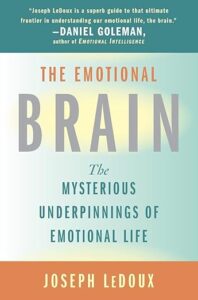
I think the thing that really helped me in the late 90s was understanding that this was a software problem, not a hardware problem. I’m a bit of an IT geek. I love this analogy. But let me break that down for our listeners. A lot of the problems that modern medicine treats are treated as if they’re a hardware problem. So, it says everything can be boiled down at the reductionist level to physical things wrong in my body at the biochemical level.
If I have depression, that is not because of my thinking; that is because the chemicals in the brain are somehow not at the right level. So, we need to use antidepressants and SSRIs (selective serotonin reuptake inhibitors) to change the chemical nature of our brain. Then somehow we’re going to be relieved from our depression. That’s the classic reductionist medical model.
I realized that these kinds of illnesses are not hardware problems, but software problems, in the sense that there’s nothing wrong with the computer or its physical hardware; the software program is getting stuck. It is getting into negative feedback loops, and that’s what we need to retrain, which is what I really discovered at the beginning. I started experimenting with different brain retraining techniques.
At that time, neuroplasticity and brain retraining didn’t even exist as a discipline. Therefore, it was just practicing and seeing what worked. How do I stop my brain from going down certain pathways that are creating the symptoms, thereby calming my immune system and nervous system? Through this ad hoc practice, I managed to get myself 100% well.
If someone doesn’t know anything about your program, what does it look like to enroll in the program? Does it involve neurofeedback or anything else?
Our program is unique in that it does not use invasive devices, neurofeedback, or brain stimulation, including vagus nerve stimulation. Instead, our brain retraining program suggests that there are three stages to healing from any chronic condition.
When we go into fear states, the force field around us weakens, but it becomes stronger when we surrender and say, ‘I accept whatever is happening.’ Share on XThe first stage is to learn how to regulate our nervous system. The first step in preparing for neuroplasticity involves practicing breathing techniques, meditation, and relaxation exercises. We all know now—there’s enough evidence behind this—that’s a very important part of healing from anything. The first stage involves regulating the nervous system.
The second stage is the core of it, retraining the brain. That’s where we, through our videos and app, help patients learn these highly specialized techniques. It’s very difficult to describe them, but they’re not cognitive behavioral techniques; they’re not psychotherapy. This is actually about training the brain, just like you learn to drive a car. If you were just using cognitive techniques, you might say in your very first lesson, “Hey, I’m going to be really positive. I’m going to learn to drive this car.”
But until you actually practice moving the steering wheel and pressing the gas, you won’t be able to learn to drive a car or learn to swim. This is training our nervous system in a new practice, through repetition, like learning a musical instrument. That’s what we help our patients learn: to rewire their brain so that it is no longer stuck in these old practices. The way to think about this is that, let’s say somebody has the COVID-19 infection.

Now, most people who get the COVID infection have their immune system kick in, and then it returns to normal once they fight off the virus. However, in about 20% to 30% of people, we know that in the medium term, they experience lingering symptoms for many weeks. For a few percent of people, these symptoms persist for months, if not years, afterwards. Now what is happening there?
We believe it’s very simple. The brain, when it’s fighting off the virus, is a life-threatening experience. We may take it for granted, but it’s actually life-threatening. The brain, when it takes a long time to fight off COVID-19, becomes stuck. It fights off the virus, but it thinks, “What happens if the virus is still in my brain or still in my body?” Then it goes into overdrive mode, becoming overly defensive, and continues to stimulate the nervous and immune systems.
Our program is then designed to train the nervous and immune system to come back to balance so that we no longer have the condition. The third R of our program, as I said, is delivered through videos and audios, and is what we call re-engaging with joy. What that means is that once you have retrained your brain, it remains sensitive for a while. If you go back into normal life and start working 60-hour weeks, or you start pushing yourself too hard, your brain is going to go back into that danger mode, defensive mode, and start re-triggering these defensive responses, causing the symptoms.
Learning about your stress triggers, understanding your personality traits, and recognizing what stresses you are fundamentally important to maintaining long-term health.
Therefore, learning about your stress triggers, understanding your personality traits, and recognizing what stresses you are fundamentally important to maintaining long-term health. We are talking about chronic diseases such as chronic fatigue, long COVID, and fibromyalgia, but we also treat people with PTSD. Well, not so much PTSD, but anxiety, burnout, and chronic stress.
Now, those are endemic in our population at the moment, but it’s a similar principle that we might be stressed one day, but how does that stress on one particular day then turn into chronic anxiety when we try to rest, but still, our brain is stuck in chronic anxiety? That is a result of this training of the nervous system.
That’s amazing. I’m in Israel now, and they have a war. That means you have an alert on your phone, like “You got three minutes before the siren,” a super loud siren, and you have to run for shelter. You sit there in the shelter, close your metal window, close your door, and then the building shakes. You actually hear the blasts. You hear your mom’s building just collapsed from a missile.
I have a bunch of tools that I gathered throughout the years to calm down. I’m listening to meditations. But when those things happen, my heart starts racing. I’m sure my stress is chronic, because you go to sleep and a minute later you have to wake up and run to the safe room again. You go to sleep, and your heart is racing. Then, I’m almost falling asleep, and “Oh, wait, wait, we have to run.”
This is not pretend life-threatening. This is life-threatening, period. Plus, you watch the news. You have to watch the news. You see the devastation. You hear the great leaders of the new world saying, “Tehran is gonna be on fire. Tel Aviv is gonna be on fire.” Everything is emphasized, and you do see the destruction. My friend’s parents just lost their home. They’re safe, but people died, and they’re wounded.
Living in Israel is really crazy, because in between that, you kind of try to live a normal life, to record a podcast, to connect with your friends, to organize play dates, all those common things. What I know about the brain is that even perceived dangers, like you said, for the brain, feel like real danger. It’s not whether we see it on the news or we experience it, just like the perceived danger when somebody scares you, that can linger and become chronic, I guess.
We conserve our energy and our mind when we stop losing it to fear, anger, or upset. That energy is better spent supporting the people around us in difficult times. Share on XWhat are some practical advice or things that someone can do in order to handle that?
Firstly, Orion, I really feel for you and your family and everyone there in the war. It’s a very challenging situation, so I really am sorry to hear what you are going through, and for everybody else as well.
And I want you to know, not many people know, but Israelis really like Iranian people. The problem is the extreme government they have there. But you know, when Iranians and Israelis meet, they usually love each other, unless they are extreme. They believe in a form of Islam that thinks that the Messiah is going to come if Israel is destructed, then probably not so good friends. But this is terrible on both sides. It’s not good at all.
Of course. I think this is the important thing that you are emphasizing here. The difference between the politics and the people is so, so important, because if we brand a whole people as a reflection of the politics or the government, then we are losing our shared humanity. It’s so important that we still learn that people are people. I travel the world. I’m sure you do as well.

You meet so many different people, and you realize they are coming up against the same problems, the same challenges, and the same human frailties that we all experience. We are one brotherhood, mankind, or womankind, and we need to go beyond politics and what separates us to have that human empathy with what our fellow man and woman is going through right now; then we can get beyond this.
And most importantly, you emphasize that we still love the people. It’s not about the people here.
My mom was born in Tunisia. She came to Israel when she was one, and during Nazi times, their Muslim friends were hiding them. There is a lot of love between people. There is usually no war, but when it comes to brainwash and dogma and extreme religion, that’s what creates the problem. But that’s a completely different topic. For somebody who’s going through that, no matter where they are in the world, what can we do?
Well, this is actually a very important part of what is going on and why we feel that anxiety is often because there’s a sense of separation. Our political leaders try to create this sense of ‘them’ and ‘us,’ a sense of separation, which triggers the amygdala. The amygdala part of our brain is the part that creates fear, anxiety, anger, and panic.
The brain can become overprotective, magnifying the sense of danger and affecting our health, ultimately preventing us from thinking clearly.
As you say, in your situation, it’s not even a perception. There is a real physical danger that is going on. The brain is working correctly in that situation. The challenge is that, once again, the brain can become overprotective, magnifying the sense of danger and affecting our health, ultimately preventing us from thinking clearly.
I actually like that. Two nights ago, I felt real physical pain in my chest. I see everybody around me trying to become that. Everybody’s on edge. Everybody’s sleep deprived. For a few nights, you have to wake up three or four times during the night with super loud noises. That affects people’s brains too—you’re correct judgment.
What we know from these types of experiences people have, to prevent long-term anxiety, stress, or PTSD that can come from experiences, learning for us, actually to calm our mind in the midst of what is going on, is such an important thing. Naturally, people will say, “Well, how can you do that when there are bombs going off and various things?” It is about us finding what helps us ground ourselves and what helps us center ourselves amid the storm.
I’d like to talk about the four things that we can do to support our mental and physical well-being. These four pillars stand for MEND. It’s a nice and easy acronym to remember. So M is for mind, the most important. In that regard, of course, the breathing and meditation techniques are what we found to be the most powerful way of calming down in that moment. However, I’ll share how that links with the other three factors in a moment.
Sometimes when we’re feeling this danger around us, our vibration, we become disembodied, because being in the body feels scary. Being in a situation feels scary. Our consciousness actually starts vibrating outside of our body.
You felt it. I totally felt it a couple of days ago. I had to bring my awareness to the tip of my toes, bring mindfulness, and feel my body. Because I’m a mom. I have to be here for my son, for my sisters, for my elderly mom who just went through something, for everybody. I can’t afford getting out of my body. I need to be here, and I need to be present.
Many people don’t realize this, but actually, the purpose of breathing is ultimately to take you to a deeper door of meditation.
Exactly. I think the first step, for anyone in these situations, is to recognize that it’s likely you will try to dissociate from your body as a protective measure, because it feels just too scary to be in your body, and that’s what we want to counteract to a certain extent, because that is a short term, acute danger response. But it’s not going to help you for weeks and weeks and weeks. You can’t be dissociated.
I didn’t stay there for long. I think it was like an hour. I set myself up like, “Wait a minute, why don’t you go play cards with your little one. What are you doing?”
Exactly. What I would then recommend is for people to ground. This involves literally placing your feet flat on the floor, so that you are connected to Mother Earth, and then feeling as though you have roots emerging from the bottom of your feet, connecting you to the earth. Then, what we call progressive muscle relaxation is actually feeling your feet, then your ankles, legs, torso, and body scanning so that you feel into your muscles.
Each time you feel into your muscles, you take a deep breath in and breathe out. The first step is to ground your feet on the floor, so you feel connected. Then, observe the different muscles as you breathe slowly and deeply, which prepares you for meditation. Many people don’t realize this, but actually, the purpose of breathing is ultimately to take you to a deeper door of meditation. So, we start with breath work to calm the mind and body to agree on ground.
Then, we go into a kind of guided meditation, or our own meditation. That is one aspect of MEND of the mind that is really working to find what works for you in that regard. Some people will find that a particular breathwork technique works for them. Other people will find that physically shaking their body, like shaking out the stress from their legs and arms, helps them in that moment.
Because when we go through a scary experience, we shake, right? We sometimes shake. But if we repress that shaking when it’s scary, then it gets stored up as tension in the muscle. There are things called tension release exercises. Physically shaking our body can be very beneficial.
It is a yoga pose. It’s like the cockroach or something, or it’s just shaking.
I think there is one, yes.
I actually found my body shaking a couple of nights ago, when I woke up in the middle of the night, and I thought, “Oh, I guess I’m cold because of the AC.” But it was not the AC. My body was just shaking. I was just like, “Okay, let’s go with it.” I understand that, because when there’s a deer in a headlight, that’s what they do. When an animal is scared, it shakes to release everything, putting their awareness into its body.
I did that. But I also imagined my soul entering my body. I called in soul fragments to go and live in my body, to come back to myself. And for me, I was also doing energetic protection and calling my angels, my guides, and my God. Having that load lifted off my shoulders, knowing I’m protected, and realizing there’s a bigger plan for me, my family, and for each of us, is reassuring. It’s like putting shields around each family member, our safe room, and our building.
When I’m not tired, I expand it to the country, to the world, and fill it with golden light. Somebody even told me to fill it with turquoise light, because that’s very healing and calming. I know it sounds like a made-up, imaginary concept or something that involves our imagination, but because I feel like we live in a matrix and can influence our reality, I totally believe that all that woo-woo stuff works. I feel it to my core.
Of course, yes, myself also. I think there’s something around what we have control over. We have control or influence only over our own consciousness, our own state of being. We can have influence on the situations around us, but the first port of call is our own consciousness. If we are anxious, we’re going to bring more anxiety into the world. If we are fearful, that’s what we start manifesting in our world.
The fundamental, powerful state of consciousness is to believe, ‘I’m being taken care of. There is a bigger plan here.’
What can we actually do ourselves to calm our nervous system and relax our own consciousness? One of the fundamental ways that you’ve described there: the fundamental, powerful state of consciousness, is to believe, ‘I’m being taken care of. There is a bigger plan here.’ Rather than resisting what is going on, all I can do is let go and have faith and have trust that whatever happens, I will be okay. This will be okay because we don’t have control over that.
“I will be okay. I will get through this. I will handle this.” I felt challenges before. You know, Israel, Middle East, Palestine, these are all places that I’ve had so many challenges over many, many years. But people come through and come back to normal life, and things move forward. That sense of, “I’m okay, I will be okay. I’m being taken care of, and there is a bigger purpose that I can’t see,” is so powerful at letting go.
Ultimately, it comes down to that word ‘surrender.’ Surrender is a word which has so many different meanings and so many different misconstructions around it. But ultimately, that surrender is, “I let go of my resistance. I accept what is happening. I flow with these ups and downs of life.” That’s where the force field around us becomes stronger.
Because the force field becomes weaker when we go into fear states, but it becomes stronger when we let go and say, “I accept and surrender whatever is happening. Let this be. Because I can resist and control and be in fear,” and that is going to help. Then we save our energy. We save our minds. We stop losing energy.
Every time we are afraid, every time we’re angry, every time we’re upset, we just lose some energy there. But when we look to conserve it, we can be in a better place to support our friends, family, and the people around us during these difficult times.
Yeah, when we’re angry, I think it lowers our immune system for about six hours.
Fear, anxiety, and anger are the core of the amygdala. When we experience them, we get an instant drop in our physical immune system’s strength.
Fear and anxiety, or the anger, as you say, are the core of the amygdala. When we experience them, we get an instant drop in our physical immune system’s strength, and so conserving that is so important. At the same time, we also want to accept our vulnerability and validate it. So if we are finding this hard naturally, if we are having anxiety, we’re having panic, it’s validating ourselves, because sometimes we think, “Oh, I should be stronger than this. I should be there for my children.” But it’s validating our own experience and saying, “I deserve to be okay with feeling these strong emotions, because this is a challenging situation.”
When I spent some time in India at Oneness University, we took a program there, and one of the monks said, “Let the tiger devour you.” This meant that you want to feel all your emotions, but don’t stay there for too long. I actually found myself having those conversations in my mind, like, “Oh, I have to be strong. I’m a coach, I know better than that.”
And then one moment, “Hold on, hug that little girl. Tell her, ‘It’s okay. We’re going through a hard time. It is fine,’” and I found myself actually doing it and accepting my emotions and how I feel. That’s why I’m openly sharing it, because there is no shame or fear in being scared or feeling anxiety, because then it becomes even more anxiety. You get stressed about having anxiety, and it’s just a terrible loop.
It’s about taking a moment of self-reflection and just being like, “I’m okay. It’s okay to feel my feelings.” It’s like an Imago Dialogue. It’s a relationship tool by Harville Hendrix and Helen, where you just reflect to your partner empathy and say, instead of “You’re right,” or “I’m right,” you say, “I understand that if this happened at that moment, I would feel the same. I see how you can feel this way if this and this happened to you,” and just by having the person being validated, the argument can be disappearing.
You don’t have to be right or wrong. It doesn’t mean that you finish the argument or come to some agreement, but the intensity is being left off, and then you calm down. From a calm place, you can then handle things. So, I think self-validation works the same way.
To heal, we must neither overindulge in our emotions nor repress them. The key is to validate them — to say, ‘It’s okay to feel this way, and I still love myself.’ Share on XWhen I don’t have that war in my mind about needing to be strong in a certain way, or having some thoughts that are not even my thoughts, probably, but we’ve learned somewhere in childhood or through movies or through whatever our society teaches us that we should be.
I put that aside. I can be more grounded, connected, and accepting of myself, my reality, my emotions, and then you can calm down. You can do breathing. You can do all those techniques. Then, you can handle everything better.
I love that. Absolutely, Orion. I really love the way you’ve explained that. The way we describe this in the program is we say it’s like riding a bike. When you’re riding a bike, you have that perfect balance. Now, when an emotion comes along, what can tip us off our balance? First of all, if we go too far to the left and become too engaged in our emotions, we can become overwhelmed by them, believe them, and get carried away.
Emotions aren’t something we show as a civilization. It’s very endemic.
As a result, we become anxious about the anxiety itself. We start feeling it more and more, and it builds up, building up into full-blown panic, and it’s a continuous process. That’s when we indulge our emotions and overengage with them. So, we get off our bike, and we come back to center. If we go the other way, which is to repress our emotions, some of us have learned that emotions aren’t good. They show weakness. You have to be strong; emotions aren’t something we show as a civilization.
And actually, this is something that’s very endemic, certainly in the British population, funny enough. If we go too far that way, then we start being unbalanced, where we start repressing and pushing away. In that way, the emotion doesn’t get processed, so it gets stuck in the energy centers of the body. That’s why we can feel intense fear as a heaviness and a pain in the chest. We can feel anger as headaches and migraines because of the repressed emotion.
But to come back to center is to say, “I neither overindulge my emotions, nor do I repress them.” I validate in the center. I validate how I’m feeling. It’s okay to feel these emotions, and I’m still a good person. I value myself and love myself with these emotions. As you say, from that place, with that self compassion, that self love, it’s easier to then engage with the practices, because we have validated what we are going through.
So my mom, it feels like she’s repressing her emotions, and she’s getting a lot of headaches lately. What can I do to help her connect and validate her emotions?
I think this is really communicating your own experiences and giving the other person space, because sometimes people don’t want to open up. I mean, obviously, you know, we see this in relationships. We can see this in family relationships and romantic relationships, where we want the other person to open up, so we encourage them to share because we believe it’s good for them. That can occasionally work.
We are wired for protection, survival, and defense — and that wiring makes the world appear more dangerous than it actually is. Share on XBut generally, it’s about when we share what we are going through and how we are processing our emotions and how we’re feeling, we open up a space for them to voluntarily come forward and say, “Yes, this is how I’m feeling.” Or you may even ask that person, “How are you feeling? How does this make you feel?” Without too much pressure, because people are clever. They know when, “Oh, someone’s trying to get something out of me here,” and then we see someone voluntarily sharing their experiences and emotions.
Sharing is so important because if we don’t share those emotions, it’s more likely that we tip the bike to the right-hand side and start repressing and pushing down the emotions, which then causes long-term disease. We can say that even long-term disease is a factor, or some diseases certainly are contributed to by the repression of these emotions, and instead, want to bring them up and validate them.
With your experience and scientific background, having worked with many people you helped heal, do you feel that anyone can heal? What can prevent one’s healing?
It’s difficult to say everyone, but I would say the vast majority of people can heal from chronic conditions, whether it’s anxiety, burnout, long COVID, or pain. We have people who’ve had pain for 30 years, nothing’s helped, and we’ve been able to heal their pain. What we say is, when the doctor has told you, “Look, here are some pills, but that’s all I can do for you,” and you still have the symptoms.

Then this means that it is a software problem, and we empower people to say you can influence the course of your disease or your condition, you can improve your health and well-being, and we think the vast majority of people can heal for sure.
What are your three top tips for living a stellar life?
Well, we were talking about the four pillars of MEND. M is for mind—having a calm, relaxed mind. E is for exercise, some physical activity we do each day. N is for nighttime. That means your nighttime routine and your sleep. And D is for diet.
I have so many more questions, quickly. What’s a good nighttime routine? Are you talking about the ketogenic diet, which is high in protein and fat? What type of diet?
Obviously, there are 1,001 diets out there. What we focus on in terms of the D for diet is what we call the anti-inflammatory and anti-anxiety diet. We were focusing on those two aspects. Generally, what we recommend is cutting out the things that stimulate and trigger our nervous system. They would be the obvious things like sugar.
Caffeine, white rice.
Generally, what we recommend is cutting out the things that stimulate and trigger our nervous system. They would be the obvious things like sugar.
White flour. All those usual things exactly. Then, obviously, as you say, we need good quality protein and ensure that we are consuming lots of fruits and vegetables that we know are calming to the nervous system. We also need to have carbs, but make sure they’re complex carbs and not adding a ton of sugar to your system. All of these things can support our nervous system and can reduce anxiety.
And, of course, there are many supplements, such as ashwagandha and various other substances, that can support the calming of the nervous system. What we say to people is that sometimes we become too obsessed with diet, but it can become an obsession. But actually, out of the four MEND, we know that in terms of reducing anxiety, the first three pillars certainly are far more effective. We don’t want to become too obsessed with our diets.
Instead, we want to have a calm mind through our regular meditation, breathwork, and validating ourselves. E is for exercise. You’ve mentioned the experiences that you are having right now. When we go through stress and chronic stress and anxiety, we get a buildup of cortisol, adrenaline, and noradrenaline in our brain and body. Sometimes you can do a lot of breathing and meditation, but those hormones are in your body and need to be released and relieved to allow the relaxation to occur.
Physical movement is so important. What people don’t realize is that in the ancient East, in India, when these Vedic techniques were being practiced, there were stages to how we got our nervous system calm. The first stage was physical activity. They would do vigorous activity, vigorous movement, to remove the stress hormones from the body. That is the first step. Then, the second step would be moving from that vigorous yoga to calming yoga, like a meditation for the body.
Then, the third step would be breathwork, followed by the fourth step, which is meditation. In that chain of events, everything was leading to the outside to the inner world, so calming the physical body right through to connecting with our spirit and our soul. Along that journey, the exercise component in the environment you’re in is crucial because we are building up all these stress hormones.
Physical exercise is so important. Even if that just means running around your living room, if that’s all you can do, or like physical stretching and getting your heart rate up, those will help you prepare your mind to be more relaxed.
Yeah, sometimes my little one and I dance in the living room. It’s really funny. He’s five and a half, and he’s like a modern dancer. He makes up all those moves. I’m like, “Oh, you’re amazing.” Really special moments.
It’s fascinating that, as human beings, we are designed to sing and dance every day, yet most of us don’t.
It’s so interesting that we as human beings are designed to sing and dance every day, and yet most of us don’t do it. From ancient civilizations, when the sun went down, the vast majority of different communities would sing, dance, and tell stories around a fire. Now, television has become the modern campfire of our civilization, where we sit in a chair and watch violence and craziness, right?
And so in the evenings, when you are once again in the environment that you’re in, or any people who are experiencing stress, after dinner, we’re talking about the nighttime routine. What can you do to uplift your soul and relieve the stress of the day? Physically, dance is fantastic. Singing is fantastic. Singing and dancing at the same time gives you the perfect combination. Obviously, laughing, joy, all of those things help calm the brain and the body, ready for sleep.
But instead, what are we doing in our modern civilization? We are having dinner, and many of us are watching television as we’re even having our food, and then what we are doing is going on our screens and devices, learning about all the craziness in the world, all the negative news, and doing that right till we sleep, and then expecting that our mind is going to have a good night’s sleep.
After dinner, we want to turn off bad news. We want to turn off anything stimulating, and focus on connecting to our inner joy.
I can’t. I have to look at what’s going on. When can we get under the shelter? In normal days, in normal days.
Even in your situation, there is something that we recommend. We did a special event. A lot of our brain retrainers, after Trump was elected in the US, were having panic attacks and were like, “Oh my gosh, what’s going to happen,” and all these kinds of things. We told people, “There’s something very important about how you consume news.” I totally agree. You have to keep up with the events, because it’s very important for your life.
At the same time, if we consume it in written form, it is better for our nervous system than videos and TV. The reason is that when we watch television, they are deliberately attempting to stimulate our nervous system, because then they get more eyeballs, and people watch the news. When we watch news and videos, our brain can’t distinguish between what’s real and what’s imagined.
When some other place is getting bombed or whatever, our brain feels like it’s actually happening to us, so it’s re-experiencing the trauma that it doesn’t need to re-experience. What’s important is that when we consume news as much as possible, and I appreciate that it’s a balance, can we read it instead of watching the news?
We are all works in progress. Sometimes, we take a few steps forward, look back, and then face a test. All of that ultimately helps us strengthen our resolve and our sense of connection to God.
Just read the headlines instead of reading the article, which I started doing. I’m just like, “Okay, got you. Thank you for telling me about that murder and that thing. Uninterested.” But usually in peaceful times, I try not to even follow. But now it’s almost like a part of the nervous system regulation, where you’re just like, “You are from prehistoric times.” We are meant to be afraid of the cybertooth tiger, and now we see it on the news.
We don’t know if it’s a real tiger or not a tiger. Even with government, that’s why I was laughing. The right wing and the left wing are all controlled by the same hand. It’s like divide and conquer. And we make such a big emphasis on who’s in government. The end of the day, there is a government behind the government that controls all the governments, and it doesn’t matter which one you vote for.
That’s just my extreme opinion on the matter, but it’s all part of the illusion and the matrix we live in, which is why we get scared of so many things. That’s very different from actually hearing the building shake. As you said, we decreased our consumption of all this news, because most of it is fake news. Even now, after seeing a new AI that can create videos that look exactly like real life.
I’ve been thinking to myself, “How long have we really had this technology and been able to do what we see on the news in the last few years? Is it even real? What are those programs programming us, and how can we, as sovereign human beings, get out of those subliminal messaging and mind control and have our own connection to God, to channel and be at peace with ourselves, regardless of everything that’s happened outside and live in the eye of the storm?” Easier said than done sometimes.
Well, that’s what gives the idea that we are all work in progress. We are all moving towards that vision and that goal. Sometimes we’ll move a few steps forward, and we’ll look back, and then we’ll be tested. We’ll be going through testing challenging times, as you are right now. All of that ultimately helps us strengthen our resolve and our sense of connection to whatever we call it: the divine, God, the universe, love.
Yes, it’s amazing. Wow. It was so nice talking to you. I really appreciate your kindness, your wisdom, and everything you shared with us. It just seems like you’re a really kind-hearted human being.
Thank you for everything that you’re doing in the world and helping so many people with your training. That’s amazing. It’s truly beautiful to meet people who have found their passion and are living their destiny, and have been a light in the world. Thank you for that, and thank you for being here.
Thank you so much for your kind words, Orion. Likewise, the amazing work you’re also doing with your podcast, as well as the work you do with women, I think, is amazing.
Thank you. And thank you, listeners. Remember to keep your mind calm, exercise, and relax at nighttime. I also recommend magnesium; it’s awesome. And improve your diet. Have a diet that is super good for youth, full of good proteins, good fats and healthy carbohydrates. Just take care of yourself – take care of your body, mind, heart, and soul – and have a stellar life. This is Orion, till next time.
